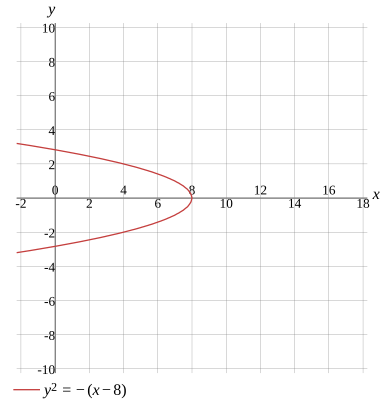Question
Identify the conic
Find the standard equation of the parabola
Find the vertex of the parabola
Find the focus of the parabola
Load more

y2=−(x−8)
Evaluate
3−(x−5)=y2
Subtract the terms
More Steps


Evaluate
3−(x−5)
If a negative sign or a subtraction symbol appears outside parentheses, remove the parentheses and change the sign of every term within the parentheses
3−x+5
Add the numbers
8−x
8−x=y2
Swap the sides of the equation
y2=8−x
Use the commutative property to reorder the terms
y2=−x+8
Solution
y2=−(x−8)
Show Solution

Solve the equation
Solve for x
Solve for y
x=−y2+8
Evaluate
3−(x−5)=y2
Subtract the terms
More Steps


Evaluate
3−(x−5)
If a negative sign or a subtraction symbol appears outside parentheses, remove the parentheses and change the sign of every term within the parentheses
3−x+5
Add the numbers
8−x
8−x=y2
Move the constant to the right-hand side and change its sign
−x=y2−8
Solution
x=−y2+8
Show Solution

Testing for symmetry
Testing for symmetry about the origin
Testing for symmetry about the x-axis
Testing for symmetry about the y-axis
Not symmetry with respect to the origin
Evaluate
3−(x−5)=y2
Simplify the expression
8−x=y2
To test if the graph of 3−(x−5)=y2 is symmetry with respect to the origin,substitute -x for x and -y for y
8−(−x)=(−y)2
Evaluate
8+x=(−y)2
Evaluate
8+x=y2
Solution
Not symmetry with respect to the origin
Show Solution

Find the first derivative
Find the derivative with respect to x
Find the derivative with respect to y
dxdy=−2y1
Calculate
3−(x−5)=y2
Simplify the expression
8−x=y2
Take the derivative of both sides
dxd(8−x)=dxd(y2)
Calculate the derivative
More Steps


Evaluate
dxd(8−x)
Use differentiation rules
dxd(8)+dxd(−x)
Use dxd(c)=0 to find derivative
0+dxd(−x)
Evaluate the derivative
More Steps


Evaluate
dxd(−x)
Use differentiation rule dxd(cf(x))=c×dxd(f(x))
−dxd(x)
Use dxdxn=nxn−1 to find derivative
−1
0−1
Evaluate
−1
−1=dxd(y2)
Calculate the derivative
More Steps


Evaluate
dxd(y2)
Use differentiation rules
dyd(y2)×dxdy
Use dxdxn=nxn−1 to find derivative
2ydxdy
−1=2ydxdy
Swap the sides of the equation
2ydxdy=−1
Divide both sides
2y2ydxdy=2y−1
Divide the numbers
dxdy=2y−1
Solution
dxdy=−2y1
Show Solution

Find the second derivative
Find the second derivative with respect to x
Find the second derivative with respect to y
dx2d2y=−4y31
Calculate
3−(x−5)=y2
Simplify the expression
8−x=y2
Take the derivative of both sides
dxd(8−x)=dxd(y2)
Calculate the derivative
More Steps


Evaluate
dxd(8−x)
Use differentiation rules
dxd(8)+dxd(−x)
Use dxd(c)=0 to find derivative
0+dxd(−x)
Evaluate the derivative
More Steps


Evaluate
dxd(−x)
Use differentiation rule dxd(cf(x))=c×dxd(f(x))
−dxd(x)
Use dxdxn=nxn−1 to find derivative
−1
0−1
Evaluate
−1
−1=dxd(y2)
Calculate the derivative
More Steps


Evaluate
dxd(y2)
Use differentiation rules
dyd(y2)×dxdy
Use dxdxn=nxn−1 to find derivative
2ydxdy
−1=2ydxdy
Swap the sides of the equation
2ydxdy=−1
Divide both sides
2y2ydxdy=2y−1
Divide the numbers
dxdy=2y−1
Use b−a=−ba=−ba to rewrite the fraction
dxdy=−2y1
Take the derivative of both sides
dxd(dxdy)=dxd(−2y1)
Calculate the derivative
dx2d2y=dxd(−2y1)
Use differentiation rules
dx2d2y=−21×dxd(y1)
Rewrite the expression in exponential form
dx2d2y=−21×dxd(y−1)
Calculate the derivative
More Steps


Evaluate
dxd(y−1)
Use differentiation rules
dyd(y−1)×dxdy
Use dxdxn=nxn−1 to find derivative
−y−2dxdy
dx2d2y=−21(−y−2dxdy)
Rewrite the expression
dx2d2y=−21(−y2dxdy)
Calculate
dx2d2y=2y2dxdy
Use equation dxdy=−2y1 to substitute
dx2d2y=2y2−2y1
Solution
More Steps


Calculate
2y2−2y1
Multiply by the reciprocal
−2y1×2y21
Multiply the terms
−2y×2y21
Multiply the terms
More Steps


Evaluate
2y×2y2
Multiply the numbers
4y×y2
Multiply the terms
4y3
−4y31
dx2d2y=−4y31
Show Solution

Rewrite the equation
r=−2sin2(θ)cos(θ)+31sin2(θ)+33r=2sin2(θ)−cos(θ)+31sin2(θ)+33
Evaluate
3−(x−5)=y2
Evaluate
More Steps


Evaluate
3−(x−5)
If a negative sign or a subtraction symbol appears outside parentheses, remove the parentheses and change the sign of every term within the parentheses
3−x+5
Add the numbers
8−x
8−x=y2
Move the expression to the left side
8−x−y2=0
To convert the equation to polar coordinates,substitute x for rcos(θ) and y for rsin(θ)
8−cos(θ)×r−(sin(θ)×r)2=0
Factor the expression
−sin2(θ)×r2−cos(θ)×r+8=0
Solve using the quadratic formula
r=−2sin2(θ)cos(θ)±(−cos(θ))2−4(−sin2(θ))×8
Simplify
r=−2sin2(θ)cos(θ)±31sin2(θ)+33
Separate the equation into 2 possible cases
r=−2sin2(θ)cos(θ)+31sin2(θ)+33r=−2sin2(θ)cos(θ)−31sin2(θ)+33
Use b−a=−ba=−ba to rewrite the fraction
r=−2sin2(θ)cos(θ)+31sin2(θ)+33r=−2sin2(θ)cos(θ)−31sin2(θ)+33
Solution
More Steps


Evaluate
−2sin2(θ)cos(θ)−31sin2(θ)+33
Use b−a=−ba=−ba to rewrite the fraction
−2sin2(θ)cos(θ)−31sin2(θ)+33
Rewrite the expression
2sin2(θ)−cos(θ)+31sin2(θ)+33
r=−2sin2(θ)cos(θ)+31sin2(θ)+33r=2sin2(θ)−cos(θ)+31sin2(θ)+33
Show Solution

Graph
